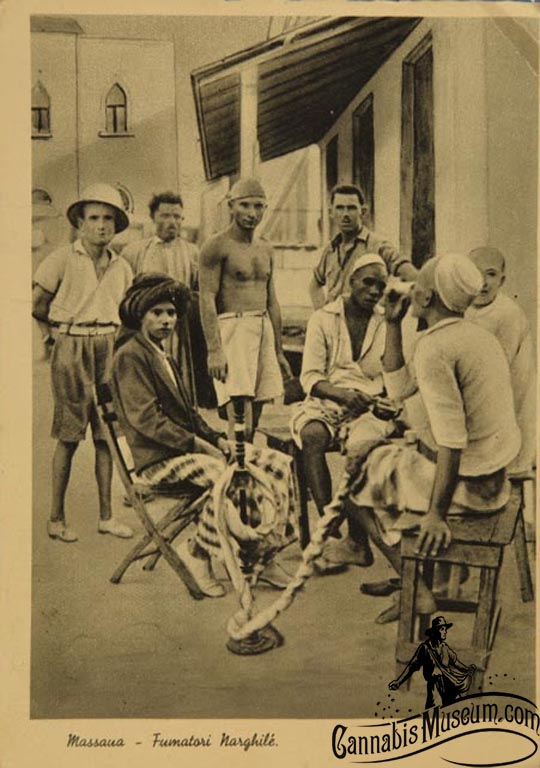Massaua: Fumatori Narghile
Dublin Core
Creator
Description
Photo is black and white with black text
Language
Format
Postcard Item Type Metadata
Country
Eritrea
Dimensions
(150x100mm)
Condition
Fair
Notes
Postcard is worn
Listing Title
Massawa, Eritrea - smoking a hookah - postcard c.1930s
Seller ID
Seller Notes
Postage Condition: Unposted Country/ Region: Eritrea
Number of Items: Single Period: Inter-War (1918-39)
Size: Continental/ Modern (150x100mm)
Postcard
Picture / Image: Massawa (Massaua) - [Eritrea] - Fumatosi Narghilie [smoking a hookah]
Publisher: A. A. & F. Cicero, Massaua, Asmara
Postally used: no
Stamp: n/a
Postmark(s): n/a
Sent to: n/a
Notes / condition:
Massawa (Arabic: مصوع, Maṣṣawaʿ, Italian: Massaua), also known as Mitsiwa (Ge'ez: ምጽዋዕ, Miṣṣiwa), Batsiʿ[2] (Ge'ez: ባጽዕ, Bāṣiʿ, formerly ባጽዕ, Bāṣ́iʿ), and Badi (Arabic: بِضع, Baḍiʿ), is a city on the Red Sea coast of Eritrea located at the northern end of the Gulf of Zula beside the Dahlak Archipelago. An important port for many centuries, it was ruled by a succession of polities, including the Axumite Empire, Medri Bahri Kingdom, the Umayyad Caliphate, various Beja sultanates, the Ottoman Empire, Egypt, Italy, Britain, and Ethiopia, until Eritrea's independence in 1991. Massawa was the capital of the Italian Colony of Eritrea until this was moved to Asmara in 1897.
Massawa was originally a small seaside village, lying in lands coextensive with the Kingdom of Axum in antiquity and overshadowed by the nearby port of Adulis about 50 kilometres (31 mi) to the south.[3]
Following the fall of Axum in the 8th century, the area around Massawa and the town itself became occupied by the Umayyad Caliphate from AD 702 to 750. The Beja people would also come to rule within Massawa during the Beja Kingdom of Eritrea from AD 740 to the 14th century. Massawa was sited between the sultanates of Qata, Baqulin, and Dahlak. Midri-Bahri, an Eritrean kingdom (14th–19th centuries), gained leverage at various times and ruled over Massawa. The port city would also come under the supreme control of the Balaw people (people of Arab descent), during the Balaw Kingdom of Eritrea (12th–15th centuries). At this time, the Sheikh Hanafi Mosque, Eritrea's oldest mosque, was built on Massawa Island, along with several other works of early Islamic architecture both in and around Massawa (including the Dahlak Archipelago and the Zula peninsula).
The port was a major site for the Arab slave trade and Venetian merchants were said to have lived in Massawa and nearby Suakin in the 15th century.
Massawa is home to a naval base and large dhow docks. It also has a station on the railway line to Asmara. Ferries sail to the Dahlak Islands and the nearby Green Island.
In addition, the city's air transportation needs are served by the Massawa International Airport.
Number of Items: Single Period: Inter-War (1918-39)
Size: Continental/ Modern (150x100mm)
Postcard
Picture / Image: Massawa (Massaua) - [Eritrea] - Fumatosi Narghilie [smoking a hookah]
Publisher: A. A. & F. Cicero, Massaua, Asmara
Postally used: no
Stamp: n/a
Postmark(s): n/a
Sent to: n/a
Notes / condition:
Massawa (Arabic: مصوع, Maṣṣawaʿ, Italian: Massaua), also known as Mitsiwa (Ge'ez: ምጽዋዕ, Miṣṣiwa), Batsiʿ[2] (Ge'ez: ባጽዕ, Bāṣiʿ, formerly ባጽዕ, Bāṣ́iʿ), and Badi (Arabic: بِضع, Baḍiʿ), is a city on the Red Sea coast of Eritrea located at the northern end of the Gulf of Zula beside the Dahlak Archipelago. An important port for many centuries, it was ruled by a succession of polities, including the Axumite Empire, Medri Bahri Kingdom, the Umayyad Caliphate, various Beja sultanates, the Ottoman Empire, Egypt, Italy, Britain, and Ethiopia, until Eritrea's independence in 1991. Massawa was the capital of the Italian Colony of Eritrea until this was moved to Asmara in 1897.
Massawa was originally a small seaside village, lying in lands coextensive with the Kingdom of Axum in antiquity and overshadowed by the nearby port of Adulis about 50 kilometres (31 mi) to the south.[3]
Following the fall of Axum in the 8th century, the area around Massawa and the town itself became occupied by the Umayyad Caliphate from AD 702 to 750. The Beja people would also come to rule within Massawa during the Beja Kingdom of Eritrea from AD 740 to the 14th century. Massawa was sited between the sultanates of Qata, Baqulin, and Dahlak. Midri-Bahri, an Eritrean kingdom (14th–19th centuries), gained leverage at various times and ruled over Massawa. The port city would also come under the supreme control of the Balaw people (people of Arab descent), during the Balaw Kingdom of Eritrea (12th–15th centuries). At this time, the Sheikh Hanafi Mosque, Eritrea's oldest mosque, was built on Massawa Island, along with several other works of early Islamic architecture both in and around Massawa (including the Dahlak Archipelago and the Zula peninsula).
The port was a major site for the Arab slave trade and Venetian merchants were said to have lived in Massawa and nearby Suakin in the 15th century.
Massawa is home to a naval base and large dhow docks. It also has a station on the railway line to Asmara. Ferries sail to the Dahlak Islands and the nearby Green Island.
In addition, the city's air transportation needs are served by the Massawa International Airport.
Order ID
07-05188-86241
Collection
Citation
A.A. & F. Cicero, “Massaua: Fumatori Narghile,” Wirtshafter Collection-Cannabis Museum-Athens, Ohio, accessed June 7, 2025, https://cannabismuseum.com/omeka/items/show/9412.
Geolocation
Item Relations
| This Item | Similar to | Item: Mauresque Fumant le Narguile |
| Item: Djibouti: Devant un Cafe Somalis, Native Men, Hookah | Similar to | This Item |
| Item: Arabian Chief | Similar to | This Item |
| Item: Somaly People | Similar to | This Item |
| Item: Djibouti | Similar to | This Item |


